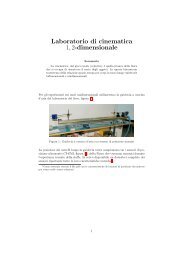Newton's law of cooling revisited - Cartan
Newton's law of cooling revisited - Cartan
Newton's law of cooling revisited - Cartan
Create successful ePaper yourself
Turn your PDF publications into a flip-book with our unique Google optimized e-Paper software.
Newton’s <strong>law</strong> <strong>of</strong> <strong>cooling</strong> <strong>revisited</strong> 1069<br />
Table 1. Some material properties <strong>of</strong> objects and respective Biot numbers.<br />
αConv λ (W αCond = λ/s Biot<br />
Object Material(s) (W/(m 2 K) −1 ) s in m (m · K) −1 ) (W(m 2 K) −1 ) number<br />
Metal cubes Aluminium, paint 2–25 20–60 × 10 −3 220 11 000–3670 220 000 ≪1<br />
can (0.5 l) water inside 3.3 × 10 −2 radius 0.6 18.2 ≈0.1<br />
Light bulbs Glass 2–25 1 × 10 −3 ≈1 1000 0.002–0.025<br />
Bottle (0.5 l) Glass with 2 ≈3 × 10 −3 ≈1 333 ≈0.006<br />
in fridge water inside 3.3 × 10 −2 radius 0.6 18.2 ≈0.1<br />
energy <strong>of</strong> the object, i.e.<br />
mc dTobj<br />
dt =−˙QConv − ˙QRad, (7)<br />
where m is the mass <strong>of</strong> the object, c is the specific heat (here assumed to be independent <strong>of</strong> T)<br />
and dTobj/dt denotes the decrease in the (uniform) temperature <strong>of</strong> the objects due to the losses.<br />
Conduction within the solid is only important for establishing a homogeneous temperature<br />
pr<strong>of</strong>ile within the objects; the heat transfer from the object to the surrounding air is due to<br />
convection and radiation.<br />
Using equations (2) and (3) for the heat losses would lead to a nonlinear differential<br />
equation which cannot be easily solved analytically. However, if the radiative <strong>cooling</strong><br />
contribution can be used in the linearized form (equation (5)), equation (7) turns into a<br />
conventional linear differential equation<br />
mc dTobj<br />
dt =−αtotal · A · (Tobj − Tsurr), where αtotal = αC + αR = αC + ε · σ · kappr. (8)<br />
Here αC accounts for the sum <strong>of</strong> conduction and convection. αtotal in addition includes the<br />
linearized radiative heat transfer. The solution for t0 = 0 is usually written as<br />
Tobj(t) = Tsurr + (TInit − Tsurr) · e −t/τ ρ · c<br />
with time constant τ = ·<br />
αtotal<br />
V<br />
. (9)<br />
A<br />
Here, ρ is the density <strong>of</strong> the object material, c is the specific heat and the volume-to-surface ratio<br />
V/A is proportional to the size <strong>of</strong> the object. Equation (9) predicts that the difference between<br />
the initial temperature TInit and surrounding air temperature Tsurr drops exponentially (this<br />
dependence is denoted as Newton’s <strong>law</strong>). Many experiments seem to support the applicability<br />
<strong>of</strong> this simplified theory for temperature difference.<br />
We briefly summarize the assumptions which led to equation (7), i.e. to Newton’s <strong>law</strong> <strong>of</strong><br />
<strong>cooling</strong>.<br />
(1) The object is characterized by a single temperature (Bi ≪ 1).<br />
(2) For small temperature differences �T (�T ≪ Tobj, Tsurr with absolute temperatures in<br />
K) the radiative heat transfer may be approximated by its linearized form (equation (5))<br />
where the heat-transfer coefficient is constant (does not depend on temperature). Below<br />
we will discuss in detail how small �T may be.<br />
(3) The convective heat-transfer coefficient is assumed to stay constant during the <strong>cooling</strong><br />
process.




